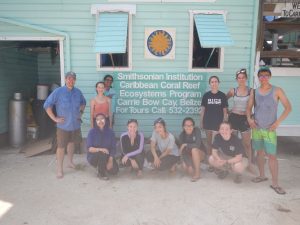Last of the Belizean days-
Today’s theme is goodbye. This morning we said goodbyes to our beloved research station, our marine safety officers, our boat captains. This afternoon we said goodbyes to Belize and tonight we said goodbyes to EBIO 319. Surely. This won’t be the last of it.

A Smithsonian tropical field biologist we visited today has been conducting research on her island, Carrie Bow Caye, for 13 years, and will plans on returning year after year. This station has been doing some very cool research on the effects of increasing temperatures on corals. Specifically, researchers there have been testing the heat tolerance of a type of hybrid between two species of coral: the staghorn and the elkhorn corals. When hybridized, the coral are able to withstand high temperatures without bleaching. The scientists there perform tolerance tests in tanks of sea water heated up to different temperatures using different replicated hybrids and nonhybrids.
This is crucial today
, in a time when the global temperatures have been rising and upsetting the intricate, interconnected ecosystem of coral reefs. Without an intact ecosystem, food production, air quality, tourism, and economies will all suffer. A resilient coral may pave the way for future developments in resilient coral reefs.
Although coral reefs have been a widely known ecosystem fundamental to many aspects of our life, mangrove forests are a lesser known, but arguable equally important ecosystem. Mangrove forests are composed of communities of mangrove trees, trees that are able to extend their roots deep into the sea water and sprout leaves above water. While exploring one of these mangroves this morning, we saw first hand the types of life that is supported by these forests: upside-down jellyfish, crustose coralline algae, y-branch algae, blistered saucer-leaf algae, schools of fish, and starfish. A unique feature of the mangrove forest is that it filters marine waters so that surrounding organisms live in more-purified water. Combined with extra
shade provided by mangrove leaves and nutrients that come from decomposing leaves, this forest gives many organisms a habitat, some for a period of their life time, and others for their whole life time.
————————————————————————————
At the airport, we all looked for souvenirs to signify our time in Belize, but truly we knew that the type of life we lived in Belize cannot be fully captured by items. The closest thing that may come to represent our Belizean day are these blog entries. Everyday has been new, and each encounter has been different. Belize, you have been great to us, truly. Now. Until next time!

